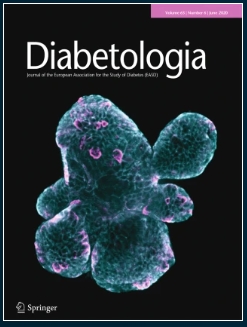Acute brain responses to hypoglycaemia and hyperglycaemia in adolescents with type 1 diabetes.
IF 10.2
1区 医学
Q1 ENDOCRINOLOGY & METABOLISM
引用次数: 0
Abstract
AIMS/HYPOTHESIS The physiological basis of the well-described neurocognitive decrements and structural brain changes in type 1 diabetes is unclear. We aimed to assess differences in cerebral blood flow (CBF) and neural activity before, during and after induced hypoglycaemia and hyperglycaemia in adolescents with type 1 diabetes. METHODS An observational hyperinsulinaemic clamp and functional MRI study was conducted. Parallel study arms assessed participants during three consecutive glycaemic phases: baseline euglycaemia (5.0±0.5 mmol/l), either hypoglycaemia (2.6±0.5 mmol/l) or hyperglycaemia (18-20 mmol/l), and euglycaemic recovery (5.0±0.5 mmol/l). During each glycaemic phase, CBF/brain perfusion was measured with arterial spin labelling and brain neural activity was measured with fractional amplitude of low frequency fluctuations. Comparative analyses were based on the seven regional functional parcellation areas (networks) of the cerebral cortex. A Bayesian multi-level regression model was employed to test regional differences in CBF and brain neural activity between the various glycaemic conditions. RESULTS Twenty adolescents with type 1 diabetes participated: ten in each of the hypoglycaemic and hyperglycaemic study arms. Relative to baseline, acute hypoglycaemia was associated with substantially reduced brain neural activity (six of seven functional networks); no significant differences in CBF were evident. By contrast, acute hyperglycaemia was associated with widespread increases in brain activity (five of seven functional networks) and decreased perfusion (six of seven functional networks). Hypoglycaemia and hyperglycaemia had symmetrically opposite effects on brain neural activity in the visual, ventral attention, dorsal attention, frontoparietal and default networks. Recovery from both hypoglycaemia and hyperglycaemia was associated with persistent alterations in both brain perfusion and neural activity, relative to baseline, despite >45 min of sustained euglycaemia. CONCLUSIONS/INTERPRETATION Across widespread areas of the brain, both brain perfusion and neural metabolic activity are altered by acute hypoglycaemia and hyperglycaemia in adolescents with type 1 diabetes. Recovery from glycaemic extremes is delayed. These findings offer important further insights into the acute cerebral responses to abnormal blood glucose levels.青少年1型糖尿病患者对低血糖和高血糖的急性脑反应
目的/假设1型糖尿病患者神经认知功能减退和脑结构改变的生理基础尚不清楚。我们的目的是评估青少年1型糖尿病患者在诱导低血糖和高血糖之前、期间和之后的脑血流量(CBF)和神经活动的差异。方法采用观察性高胰岛素钳夹和功能MRI研究。平行研究组在三个连续的血糖阶段评估参与者:基线血糖(5.0±0.5 mmol/l),低血糖(2.6±0.5 mmol/l)或高血糖(18-20 mmol/l)和血糖恢复(5.0±0.5 mmol/l)。在每个血糖期,用动脉自旋标记法测量脑血流/脑灌注,用低频波动分数幅值法测量脑神经活动。对比分析基于大脑皮层的7个区域功能包裹区(网络)。采用贝叶斯多级回归模型检验不同血糖状态下脑血流和脑神经活动的区域差异。结果20例青少年1型糖尿病患者参与了研究,低血糖组和高血糖组各10例。相对于基线,急性低血糖与脑神经活动(7个功能网络中的6个)显著降低有关;CBF无明显差异。相比之下,急性高血糖与广泛的脑活动增加(七个功能网络中的五个)和灌注减少(七个功能网络中的六个)有关。低血糖和高血糖对视觉、腹侧注意、背侧注意、额顶叶和默认网络的脑神经活动有对称相反的影响。低血糖和高血糖的恢复与脑灌注和神经活动的持续改变相关,相对于基线,尽管持续血糖45分钟。结论/解释:青少年1型糖尿病患者急性低血糖和高血糖会改变大脑广泛区域的脑灌注和神经代谢活动。从极端血糖中恢复是延迟的。这些发现为进一步了解大脑对异常血糖水平的急性反应提供了重要的见解。
本文章由计算机程序翻译,如有差异,请以英文原文为准。
求助全文
约1分钟内获得全文
求助全文
来源期刊

Diabetologia
医学-内分泌学与代谢
CiteScore
18.10
自引率
2.40%
发文量
193
审稿时长
1 months
期刊介绍:
Diabetologia, the authoritative journal dedicated to diabetes research, holds high visibility through society membership, libraries, and social media. As the official journal of the European Association for the Study of Diabetes, it is ranked in the top quartile of the 2019 JCR Impact Factors in the Endocrinology & Metabolism category. The journal boasts dedicated and expert editorial teams committed to supporting authors throughout the peer review process.
 求助内容:
求助内容: 应助结果提醒方式:
应助结果提醒方式:


